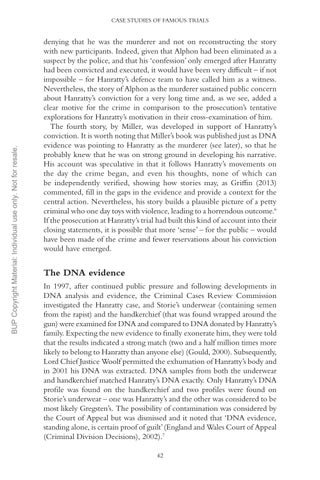BUP Copyright Material: Individual use only. Not for resale.
CASE STUDIES OF FAMOUS TRIALS
denying that he was the murderer and not on reconstructing the story with new participants. Indeed, given that Alphon had been eliminated as a suspect by the police, and that his ‘confession’ only emerged after Hanratty had been convicted and executed, it would have been very difficult – if not impossible – for Hanratty’s defence team to have called him as a witness. Nevertheless, the story of Alphon as the murderer sustained public concern about Hanratty’s conviction for a very long time and, as we see, added a clear motive for the crime in comparison to the prosecution’s tentative explorations for Hanratty’s motivation in their cross-examination of him. The fourth story, by Miller, was developed in support of Hanratty’s conviction. It is worth noting that Miller’s book was published just as DNA evidence was pointing to Hanratty as the murderer (see later), so that he probably knew that he was on strong ground in developing his narrative. His account was speculative in that it follows Hanratty’s movements on the day the crime began, and even his thoughts, none of which can be independently verified, showing how stories may, as Griffin (2013) commented, fill in the gaps in the evidence and provide a context for the central action. Nevertheless, his story builds a plausible picture of a petty criminal who one day toys with violence, leading to a horrendous outcome.6 If the prosecution at Hanratty’s trial had built this kind of account into their closing statements, it is possible that more ‘sense’ – for the public – would have been made of the crime and fewer reservations about his conviction would have emerged.
The DNA evidence In 1997, after continued public pressure and following developments in DNA analysis and evidence, the Criminal Cases Review Commission investigated the Hanratty case, and Storie’s underwear (containing semen from the rapist) and the handkerchief (that was found wrapped around the gun) were examined for DNA and compared to DNA donated by Hanratty’s family. Expecting the new evidence to finally exonerate him, they were told that the results indicated a strong match (two and a half million times more likely to belong to Hanratty than anyone else) (Gould, 2000). Subsequently, Lord Chief Justice Woolf permitted the exhumation of Hanratty’s body and in 2001 his DNA was extracted. DNA samples from both the underwear and handkerchief matched Hanratty’s DNA exactly. Only Hanratty’s DNA profile was found on the handkerchief and two profiles were found on Storie’s underwear – one was Hanratty’s and the other was considered to be most likely Gregsten’s. The possibility of contamination was considered by the Court of Appeal but was dismissed and it noted that ‘DNA evidence, standing alone, is certain proof of guilt’ (England and Wales Court of Appeal (Criminal Division Decisions), 2002).7 42

